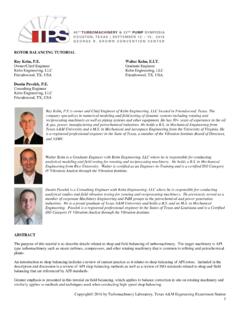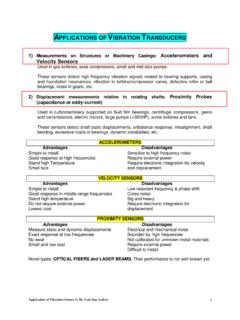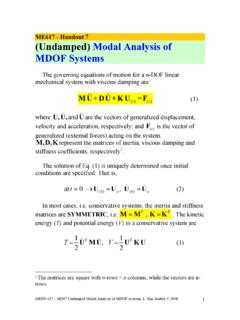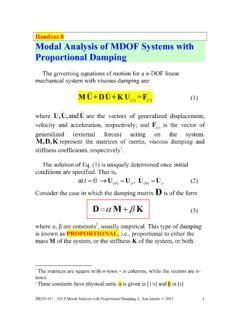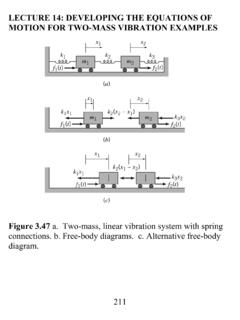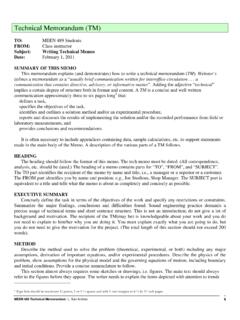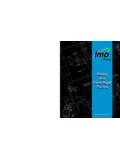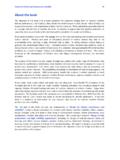Transcription of NOTES 13 SQUEEZE FILM DAMPERS OPERATION …
1 NOTES 13. SQUEEZE film DAMPERS : OPERATION , MODELS & ISSUES Dr. Luis San Andr s (2010) 1 NOTES 13 squeeze film dampers : OPERATION , MODELS AND TECHNICAL ISSUES SQUEEZE film bearing DAMPERS are lubricated elements providing viscous damping in mechanical systems. SQUEEZE film DAMPERS in rotating machinery provide structural isolation, reduce the amplitudes of rotor response to imbalance, and in some instances, assist to suppress rotordynamic instability. Background The most commonly recurring problems in rotordynamics are excessive steady state synchronous vibration levels and subsynchronous rotor instabilities. The first problem may be reduced by improved balancing, or by introducing modifications into the rotor-bearing system to move the system critical speeds out of the operating range, or by introducing external damping to limit peak amplitudes at traversed critical speeds.
2 Subsynchronous rotor instabilities may be avoided by eliminating the instability mechanism, by rising the natural frequency of the rotor-bearing system as high as possible, or by introducing damping to increase the onset rotor speed of instability [Vance 1988, Childs 1993]. Lightweight, high performance engines exhibit a trend towards increased flexibility leading to a high sensitivity to imbalance with large vibration levels and reduced reliability. SQUEEZE film DAMPERS (SFDs) are essential components of high-speed turbomachinery since they offer the unique advantages of dissipation of vibration energy and isolation of structural components, as well as the capability to improve the dynamic stability characteristics of inherently unstable rotor-bearing systems.
3 SFDs are used primarily in aircraft jet engines to provide viscous damping to rolling element bearings which themselves have little or no damping. One other important application is related to high performance compressor units where SFDs are installed in series with tilting pad bearings to reduce (soften) bearing support stiffness while providing additional damping as a safety mechanism to prevent rotordynamic instabilities. In addition, in geared compressors, the SFD assists to reduce and isolate multiple frequency excitations transmitted through the bull gear, for example. [San Andr s, 2002]. Zeidan et al. [1996] give a history of the SFD in jet engines and detail design practices for successful SFD OPERATION in commercial turbomachinery.
4 Adilleta and Della Pietra [2002] provide a comprehensive review of the relevant analytical and experimental work conducted on SFDs. San Andr s and Delgado [2007] discuss more recent SFD experimental research and present a mechanically sealed SFD impervious to air entrainment. In spite of the many successful applications, industry often recognizes that the design of SFDs is based on overly simplified predictive models that either fail to incorporate or simply neglect unique features (structural and fluidic) that affect the damper dynamic force performance. Actual damper performance can range from erratic to non-functioning depending on the operating conditions. Issues such as lubricant cavitation or air entrainment are of fundamental interest [San Andr s and Diaz, NOTES 13.]
5 SQUEEZE film DAMPERS : OPERATION , MODELS & ISSUES Dr. Luis San Andr s (2010) 22003]. Application fundamentals Figure 1 shows a typical SFD configuration consisting of an inner nonrotating journal and a stationary outer bearing, both nearly equal in diameter. The journal is mounted on the external race of a rolling element bearing and prevented from spinning with loose pins or a squirrel cage that provides a centering elastic mechanism. The annular SQUEEZE film , typically less than mm, between the journal and housing is filled with a lubricant provided as a splash from the rolling element bearing lubrication system or by a dedicated pressurized delivery. In OPERATION , as the journal moves due to dynamic forces acting on the system, the fluid is displaced to accommodate these motions.
6 As a result, hydrodynamic SQUEEZE film pressures exert reaction forces on the journal and provide for a mechanism to attenuate transmitted forces and to reduce the rotor amplitude of motion. Fig 1. SQUEEZE film damper (SFD) configuration. a) SFD with central feed groove. b) SFD with end grooves and seals [1] Figure 2 shows conceptual views of intershaft DAMPERS for multiple-spool gas turbine engines. These DAMPERS are subject to whirl motions resulting from the combined imbalance response of both low speed (LS) and high speed (HS) rotors. Most SFDs in US aircraft engines incorporate the arrangements in Figure 2(a & b) where the journal (and rolling element bearing) is elastically supported, and the bearing is rigidly attached to the engine frame.
7 The (soft) spring support and SQUEEZE film damper see the same deflections though the dynamic loads divide unequally between them. Feed groove oil inlet seal housingjournal lubricant filmshaft anti-rotation pin ball bearing (a) (b) Discharge groove Lubricant film NOTES 13. SQUEEZE film DAMPERS : OPERATION , MODELS & ISSUES Dr. Luis San Andr s (2010) 3 Ball bearing SQUEEZE film Squirrel cage Squirrel cage SQUEEZE film Ball bearing Squirrel cages SQUEEZE film LS HS HS HS LS LS (c)(b)(a) Fig. 2 Schematic views of intershaft damper configurations: a) SQUEEZE film rotates with low speed (LS) rotor, b) SQUEEZE film rotates with high speed (HS) rotor, c) double ball bearing-squirrel cage design DAMPERS in jet engines operate with low values of external pressurization (2 or 3 bar max.
8 To avoid excessive weight and volume in the lubrication system. Note also that most aircraft engines do not use any type of hydrodynamic journal bearings to avoid the risk of fluid film bearing induced instabilities. (However, in some dual shaft jet engines, the inter-spool fluid film bearing, shown in Figure 2a, is known to be a source of such instabilities). The amount of damping produced is the critical design consideration. If damping is too large, the SFD acts as a rigid constraint to the rotor-bearing system with large forces transmitted to the supporting structure. If damping is too light, the damper is ineffective and likely to permit large amplitudes of vibratory motion with likely subsynchronous motions.
9 Note also that a damping element to be effective needs to be "soft", thus allowing for motion at the location of the support, in particular for the modes of vibration of interest. The damper geometry (length, diameter and clearance), operating speed and fluid properties (density and viscosity) determine, on first instance, the dynamic forced performance of SFDs. However, there are other important considerations that ultimately determine an appropriate OPERATION . NOTES 13. SQUEEZE film DAMPERS : OPERATION , MODELS & ISSUES Dr. Luis San Andr s (2010) 4 The relevant issues are: a) kinematics of journal (tied to rotor system and acting forces) b) level of supply pressure for adequate flow rate and cooling, c) feeding and end sealing mechanisms, d) fluid inertia effects, e) type of lubricant dynamic cavitation (vapor or gaseous) or air ingestion and entrapment.
10 Models for SFD dynamic forced performance Most DAMPERS in practice are of short axial length, L/D < , and accommodate some type of end seals to increase their damping capability. SFDs include additional features such as high resistance orifices for pressure delivery and discharge and/or deep grooves acting as flow sources or sinks of uniform pressure. SQUEEZE film damper reaction forces and force coefficients are conveniently divided into two major types related to the specific journal center kinematics. For imbalance response analyses, SFD forces are obtained under the assumption of circular centered orbits. The model is applicable when the rotor traverses a critical speed, for example, where the imbalance force induces large amplitude orbital motions as the system may have little damping.
